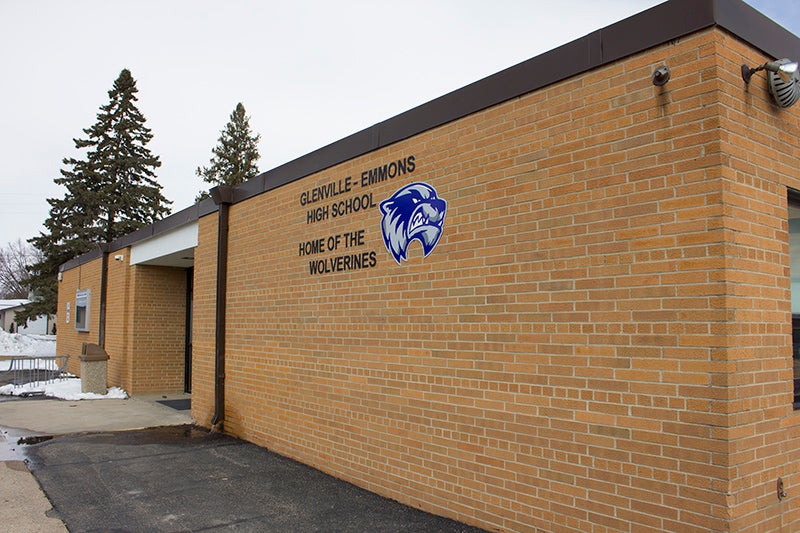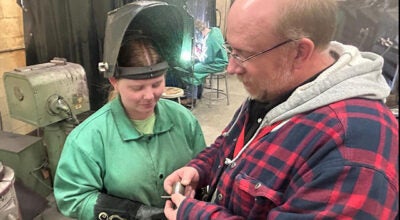Where to be in 20 years?
Published 10:00 pm Tuesday, March 27, 2018

- Glenville-Emmons junior Madison Nelson makes a poster for a book her class recently read, "Fahrenheit 451." — Sam Wilmes/Albert Lea Tribune
Glenville-Emmons begins talks about district’s future
GLENVILLE — On Monday, the Glenville-Emmons school superintendent was four meetings into an ongoing conversation about the very buildings community members met him in.
Again this year, the Glenville-Emmons school board has chosen to utilize long-term facilities maintenance revenue legislation. According to the statue, this legislation allows districts to levy taxpayers for a portion of the costs for maintenance costs as outlined in a 10-year plan updated in January, including increasing school facility accessibility, “deferred capital expenditures and maintenance projects necessary to prevent further erosion of facilities,” and certain outlined health and safety capital projects.

Glenville-Emmons Schools is evaluating possible changes at the school. — Sam Wilmes/Albert Lea Tribune
One of those approved projects is disposal of building materials containing asbestos, which Glenville-Emmons superintendent Jerry Reshetar said applies to school flooring.
There are more ideas. The roof leaks in places. The heating needs upgraded, Reshetar said, and the plumbing and electrical system could use an update, too. If he takes it a step further, he could also see a remodel for the ag room and the music facilities.
“The question is, how much do you want to fix?” Reshetar said. “How far do you want to go with this?”
Current standings
This year, the school board set a long-term facilities maintenance levy to raise $100,000, which Reshetar said will go toward repairing the school roof. He estimated a tax impact on the average Glenville home, valued at approximately $75,000, would be $8 per year. This follows last year’s levy of around $60,000, which Reshetar said went to work on the parking lot as well as restorations for the heating system.
So, six to 10 people at a time, Reshetar is presenting three options as the school board considers how to move forward with aging buildings and a small student population.
“Each one of them is a challenge,” Reshetar said of the options.
Population projections out as far as 2035 Reshetar presented to community members Monday showed population projections for area communities — Myrtle, London, Nunda, Emmons, Shell Rock and Glenville — on the decline.
Enrollment numbers, however, are not necessarily following. A graph of the data between 2011-12 and 2017-18 would look something like an upside-down bell curve: a drop in population and average class size that reaches bottom in 2014-15 and then travels back up again.
According to Reshetar, the breaking point to run a school is 18 students per grade. In 2011-12, the district clocked an average of 21.5. At its low point in 2014-15, it hit 17.5. For the current school year, the district population averages out to 20.2 students per grade.
Nonetheless, “you’re still right on the bubble,” Reshetar said.
The options
District taxpayer, school employee and mother to two in Glenville-Emmons schools is Jodi Attig. She attended Monday’s small group meeting.
“There’s plenty of stuff that needs to be fixed,” she said of the schools. “It’s just coming up with the right way to do it.”
According to Reshetar, continual long-term facilities maintenance levies is one option. Each year, the school board can plan to fix something. He estimates the school board would need to levy between $50,000 and $100,000 each year for the projects. With this strategy, Reshetar said he foresees the need for a $1,000 per student operational levy in addition to the long-term facilities maintenance funds to support both school buildings.
“You are a two-building school on a one-building budget,” Reshetar said.
The estimated tax impact for the additional operational levy would be approximately $164 per year on a $75,000 home. The last operational levy the school board passed was three years ago.
“The issue here is … are you sure you want us to spend that kind of money on this building?” he said.
The second option Reshetar presented included a rough schematic of a single site consolidation plan and a 25-year building bond, complete with referendum. The consolidation would utilize the existing high school and an addition. With a shift to one building rather than two, Reshetar estimated a yearly operational savings of approximately $336,600. This plan would also call for updates to the high school. Based on how far the updates would go, Reshetar presented tiers of financial impact, the lowest of which clocked in at an approximately $9.6 million building bond (an approximately $47 yearly tax impact on a $75,000 home).
The spendiest option was a single-site consolidation involving an entirely new building, which Reshetar estimated would require the district to issue a bond for approximately $21.6 million (in the ballpark of a $110 yearly tax impact on a $75,000 home). These numbers are a rough estimate, Reshetar emphasized, based on a square footage calculation — there have been no bids and no drawings, he said.
For John Attig, who is a taxpayer in the district and has two children attending school at Glenville-Emmons, the population is crucial to consider as the district looks at options. The district can’t base a new building on lower populations, he said.
The third option?
“Do nothing, and just hang on for as long as you can,” Reshetar said.
According to Reshetar, with the operational funds used by sustaining two buildings, the budget on its current trajectory won’t sustain itself for much longer without an operational levy.
Looking forward
Reshetar said the district does not have any plans to issue a levy. These meetings are the start of a search for the answer the community will back. The timeline for a school board decision would appear closer to the summer with a ballot in November, he estimated.
“I want you all to understand the challenge that your budget has been on,” Reshetar said. “… The board has to do something about this. They can’t keep doing what they’re doing.”
So far, Reshetar has been having meetings with farmers, trying to catch them ahead of the busy season and to discuss all of these things in addition to the state’s ag credit system.
Matt Webb graduated from the Glenville-Emmons district, as did his wife. His two children now attend school in that district, and he lives in town. He also attended Monday’s meeting.
“I think there’s options to look at,” he said. “Obviously, decisions have to be made.”
As the community moves forward, the community will need more details to make up their minds about what is best, he said.
“I don’t have a favorite, but obviously I want to see our school district stay in tact,” Webb said.
Reshetar will continue to host Monday meetings to collect input from community members. There is the need for taxes to maintain the district and for the children in the community to go to school, Reshetar said; this is the tough thing for any community that goes through this challenge. The question is, what do voters want that to look like?
“Taxpayers, what do you want to do?” Reshetar said. “This is your district. This is your school. Where’s it going to be in 20 years?”





